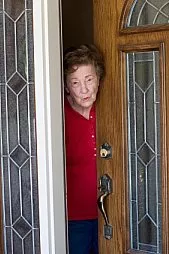Security Products:
Flaws in Home Burglar Alarms
As of 2010, this site has NO financial ties (commissions) with commercial security product retailers. This site is pro-bono – a PSA (Public Service Announcement) free to all 2+ million visitors from 162 countries.
The #1 flaw with security products is to have them, but not use them properly - or not understand their limitations. The #2 flaw is faulty installation. The #3 flaw is cheap products. Here are some examples of #1: When a home is burglarized in a quiet South African neighborhood surrounded by a high-crime area, neighbors question the homeowner to learn from their mistakes. One victim hadn’t locked his window. Another hadn't trimmed a tree branch hanging over his spiked iron fence, allowing a burglar to climb over it. Another's basement casement windows weren’t fortified, allowing access to a skinny burglar. Another was “followed-in” to his garage when coming home. Another's dog ate poisoned meat the robbers had tossed over the fence. Another had turned off her alarm system during the "safe" mid-day.
More Problems With Home Burglar Alarms
• Home burglar alarms can give you a false sense of invulnerability.
• A determined burglar may repeatedly trigger an alarm and wait until an exasperated homeowner, assuming it's broken, turns it off.
• Each family member must arm/disarm the system when doing anything unusual such as coming or going at odd hours. And some people are victimized when their system is disarmed during “safe” mornings or afternoons.
• You might still be ambushed outdoors and forced at gunpoint to disarm the system. Although you can give a secret panic alert to the monitoring company, police may be too late to rescue you.
• If you’re lucky, a police patrol car might be nearby and respond almost immediately. Otherwise, they may take anywhere from several minutes to several hours to come to your rescue (the average 911 emergency response time nationwide in the U.S. is ELEVEN minutes - an eternity in a crisis).
• There are too many false alarms. Some communities now require that home alarm monitoring companies, the property owners, or remote video systems verify from the scene that there are signs of a potential burglary in progress (like an open door or a broken window) before the police respond.
• False alarms are caused by pets tripping an alarm, inadequate training of homeowners, dead batteries, faulty installation, or cobwebs triggering sensors.
Burglar Alarms Don't Always Scare Off Burglars
Robert Cole was jolted awake by his burglar alarm in his Houston home. He came out of his bedroom with a shotgun, saw a man was in the living room, and shot him in the hip. The burglar somehow fled.At least, alarms notify the homeowners that their home is being invaded. That does give them a chance, anyway, to take defensive measures. But burglars know that police take anywhere from a few minutes to many hours to arrive.
There is NO guarantee that burglars will flee upon hearing an alarm. Most are desperate drug addicts who may gamble that they can complete their crime and escape before the police arrive. Or, a burglar may be mentally disturbed and unreasonable.
So, while burglar alarms and supplemental electronic security products are very valuable for an early warning, you also need the insights in Burglary Prevention – and the additional home security hardware in the menu at the bottom of this page.
Burglar Alarms must always be ON
Some home invaders spend days or even weeks watching their intended victim until they’re ready to strike. Then, since many homeowners lock their doors or turn on their alarm system only while they sleep, they pounce when their victims are awake, during the day or evening. They use the noise of TV sets as cover.
Secrets of Cat Burglars
Michael Bozelle, a highly skilled “cat burglar,” has burgled high-end apartments throughout North Carolina. Apartments usually don’t have individual burglar alarms and he dresses well so he looks like he belongs there.Blane Nordahl, another highly skilled cat burglar, prefers wealthy homes. He would sometimes disable the burglar alarm from outside, or set it off repeatedly until the annoyed owner turned it off. And oftentimes, the homeowners didn't even have the alarm turned on because they thought they had “location immunity” by living in a wealthy area.
Of course,
NO security products are guaranteed to prevent any crime - but might serve you well if combined with the guidance in Home Security Overview and Outdoor Safety Overview.
Crime-Safety-Security > Security Products Overview > Flaws in Electronics









